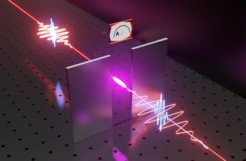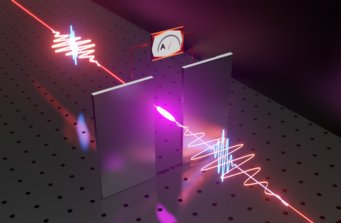Ultrafast Oscillation of Light Waves Unveiled in Plasma Spark
A German-Canadian collaboration, with physicists from the attoworld-team of the Ludwig-Maximilians-Universität München, the Max Planck Institute of Quantum Optics, and the Joint Attosecond Science Laboratory of the National Research Council and the University of Ottawa, has discovered a new way of tracing the ultrafast oscillations of the electric field in laser light waves.

Illustration of the experiment to measure the electromagnetic field of a light wave: the light wave (orange) is overlapped with a gating pulse (blue). Both pulses are focused into the air gap between two metallic electrodes, where they create a plasma spark.
The electric field of a light wave oscillates hundreds of trillions times per second, resulting in an oscillation period of the order of a few femtoseconds. The exact knowledge of this extremely fast field evolution is a prerequisite for time-resolving ultrafast processes that involve the motion of electrons in atoms, molecules or solids. Now, a team of physicists around Dr. Boris Bergues and Prof. André Staudte has developed a novel method dubbed “femtosecond streaking”, which allows resolving these fast wave oscillations.
In their study, the physicists demonstrated how the electromagnetic field of a light wave can be measured using a remarkably simple procedure. First, the researchers create a plasma spark by focusing - what they call a gating pulse - into the air gap between two metallic electrodes. The name gating pulse refers to the fact that this pulse acts as a temporal gate, during which air molecules are ionized and free electrons are produced. Then, the researchers overlap this gating pulse with the light pulse they want to sample – the so-called streaking pulse. The electric field of the streaking pulse accelerates the electrons towards one or the other electrode, thereby generating a current that depends on the delay between the two pulses. By probing the current induced between the electrodes as a function of delay, the researchers get direct access to the field of the streaking light wave. By quickly scanning the delay between the two pulses, the measured light field can be monitored in real time on a standard oscilloscope.
“A big advantage of our technique is that it works in ambient air. This contrasts with conventional streaking methods that relies on a complex and expensive vacuum setup”, explains Aleksey Korobenko, first author of the paper. Owing to its simplicity and broad applicability, this elegant method may become a valuable tool for ultrafast laser laboratories around the world and aid the development of next generation petahertz electronics.












